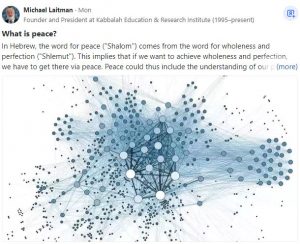
In Hebrew, the word for peace (“Shalom”) comes from the word for wholeness and perfection (“Shlemut”). This implies that if we want to achieve wholeness and perfection, we have to get there via peace.
Peace could thus include the understanding of our past and our current state, as well as truces and various agreements, but what we are most certain about is our final destination: that we would like to progress toward a perfect and whole state.
A perfect and whole state is one where various opposites complement and complete each other. As such, contrary to what is often thought about peace, it is impossible that there would be peace without war, and we should not focus on trying to bring about peace by convincing or forcing others to think like us, because it will not happen.
A state of complementary, wholeness and perfection exists in no person individually, but it comes about when we each detach from our individual selves and create a new entity in our positive connections to each other above our egos.
Peace is thus a long process involving education so that each of us can detach from our current states and reach a state where we are together, where we need to adhere to the new perfect and whole state that we build above—and disconnected from—ourselves, and where we are all connected as one.
In order to reach such a state, we need to draw the positive force of nature into our attitudes and relations to each other, in order to make peace between us so that it will start helping us operate against our egos. This process takes place without suppressing or erasing our egos. On the contrary, together with our egos, nature’s positive force will transform us into beings that have a tendency to love and bestow to one another above the divisive human ego. In other words, we draw the positive force of nature to envelop and cover our egos with its coating of love, bestowal and connection, and it will grant us the ability to behave correctly and reach a state of peace.
Written/edited by students of Kabbalist Dr. Michael Laitman. Image: Graph representing the metadata of thousands of archive documents, documenting the social network of hundreds of League of Nations personals. Grandjean, Martin (2014). “La connaissance est un réseau“. Les Cahiers du Numérique 10 (3): 37-54. DOI:10.3166/LCN.10.3.37-54
Featured in Quora